

Pareto Principle: Don't Sweat the Small Stuff. Summary: The Pareto Principle (80/20 Rule, Law of the Vital Few) is a valuable quality management tool because its application encourages a focus on the most crucial issues.

Vilfredo Pareto, 1848–1923. The Pareto Principle (also known as the 80/20 Rule or the Law of the Vital Few) More than a century ago, an Italian economist by the name of Vilfredo Pareto observed that 80% of the land in Italy was owned by 20% of the population. Subsequently, others observed a similar phenomenon in other situations, e.g. 80% of sales come from 20% of customers, 80% of the rise (or fall) in the value a stock portfolio comes from 20% of the stocks, 80% of complaints come from 20% of problems, 80% of results are contributed by 20% of the workers, etc. See Figure 1 below. Figure 1. The Pareto Principle, or 80/20 Rule, is merely an approximation and applies to typical distributions. What patients really want from hospitals. Health industries trends to watch: PwC. As the health sector moves beyond the Affordable Care Act and onto consumer-centered, digitally enabled care, here are the top 10 issues dominating the agenda in 2015.

Issue 1: Do-it-yourself healthcare US physicians and consumers are ready to embrace a dramatic expansion of the high-tech, personal medical kit. Wearable tech, smartphone-linked devices and mobile apps will become increasingly valuable in care delivery. Issue 2: Leap from mobile app to medical device A proliferation of approved and portable medical devices in patients’ homes, and on their phones, makes diagnosis and treatment more convenient, redoubling the need for strong information security systems. Issue 3: Balancing privacy and convenience Privacy will lose ground to convenience in 2015 as patients adopt digital tools and services that gather and analyze health information. Explore trends from past top health industry issues reports HRI has been naming its top health industry issues since 2006.
Primary Care Docs Pan Hospital Quality Metrics. Lena J.
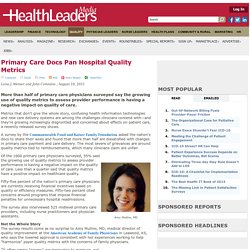
Weiner and John Commins , August 19, 2015 Metrics that don't give the whole story, confusing health information technologies and new care delivery systems are among the challenges clinicians contend with—and they're growing increasingly disgruntled and concerned about effects on patient care, a recently released survey shows. A survey by the Commonwealth Fund and Kaiser Family Foundation asked the nation's docs to share their woes and found that more than half are dissatisfied with changes in primary care payment and care delivery. The most severe of grievances are around quality metrics tied to reimbursements, which many clinicians claim are unfair. Of the 1600 primary care physicians surveyed, 55% said the growing use of quality metrics to assess provider performance is having a negative impact on the quality of care. CMS boosts funding for initiative to improve care at nursing homes. The CMS announced Thursday that it is combating the skyrocketing cost of nursing home hospitalizations by injecting funds into the Initiative to Reduce Avoidable Hospitalizations among Nursing Facility Residents.
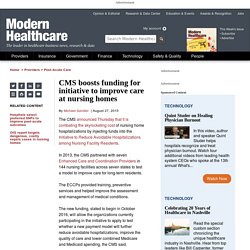
In 2013, the CMS partnered with seven Enhanced Care and Coordination Providers in 144 nursing facilities across seven states to test a model to improve care for long-term residents. The ECCPs provided training, preventive services and helped improve the assessment and management of medical conditions. The new funding, slated to begin in October 2016, will allow the organizations currently participating in the initiative to apply to test whether a new payment model will further reduce avoidable hospitalizations, improve the quality of care and lower combined Medicare and Medicaid spending, the CMS said. VA doesn't know why its hospitals have done fewer reviews of mistakes. The Veterans Affairs Department is conducting fewer reviews of medical errors, even though the number of such problems has increased, according to a report by the U.S.
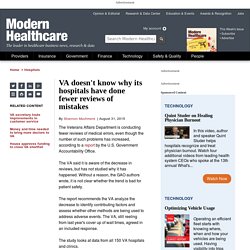
Government Accountability Office. The VA said it is aware of the decrease in reviews, but has not studied why it has happened. Without a reason, the GAO authors wrote, it is not clear whether the trend is bad for patient safety. Walkthroughs. A walkthrough, which recreates for staff the emotional and physical experiences of being a patient or family member, is an easy way to give your staff the patient’s perspective and the fastest way to identify system, flow, and attitude problems.
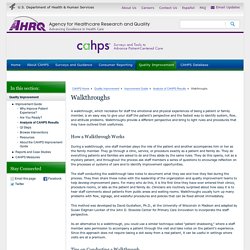
Walkthroughs provide a different perspective and bring to light rules and procedures that may have outlived their usefulness. How a Walkthrough Works During a walkthrough, one staff member plays the role of the patient and another accompanies him or her as the family member. They go through a clinic, service, or procedure exactly as a patient and family do. Technology and the Patient Experience.
This article appears in the April 2015 issue of HealthLeaders magazine.
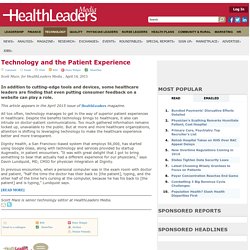
All too often, technology manages to get in the way of superior patient experiences in healthcare. Despite the benefits technology brings to healthcare, it also can intrude on doctor-patient communications. Usings EHR technology to improve quality. Troubling Findings About Patient Wait Times At VA Facilities. New data shows around one in 36 patient visits to VA medical facilities had a delay of at least a month.
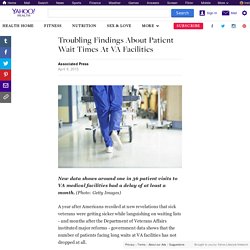
(Photo: Getty Images) A year after Americans recoiled at new revelations that sick veterans were getting sicker while languishing on waiting lists - and months after the Department of Veterans Affairs instituted major reforms - government data shows that the number of patients facing long waits at VA facilities has not dropped at all. No one expected that the VA mess could be fixed overnight.
4 reasons telemedicine will trend upward in 2015. Consumers are excited about telehealth and providers have the financial incentive and technology to make it a reality, Skip Fleshman, a partner at Asset Management Ventures, writes at Forbes.
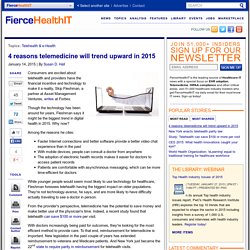
Though the technology has been around for years, Fleshman says it might be the biggest trend in digital health in 2015. Healthcare outlook 2015: Quality push expands beyond the hospital. The push for improved quality and safety metrics in healthcare will expand beyond the hospitals to the entire continuum of care in 2015.

Safety leaders are broadening their focus to include outpatient centers, home-care facilities and dialysis clinics. And there will be increased attention to diagnostic errors. There was momentum in this direction in 2014 as the CMS moved ahead with plans to adopt its star rating system across all Medicare.gov Compare websites. The program, which has rated nursing homes since 2008, was expanded to physician groups, kidney dialysis providers and home health agencies. Hospitals are expected to be added in the coming months. Providers faced increasing penalties for poor performance in reducing hospital-acquired conditions. In 2015, the Institute of Medicine and the National Patient Safety Foundation plan to release a report analyzing where the U.S. stands on healthcare quality. 2013 – Is there a Nursing Shortage? By Rose O. Sherman, EdD, RN, FAAN We have just begun our spring semester at colleges and schools of nursing throughout the country.
Many senior nursing students will soon become new graduates. They are already worrying about their job prospects based on the feedback that they have received from last year’s graduates and recent stories in the media. Minnesota Hospital Quality Reports. Building the Case for Quality Improvement in the Health Care... : Quality Management in Healthcare. There is unquestionably a need for a systematic approach to improving health care delivery processes. Top Issues Confronting Hospitals. View the 2013 Top Issues press release. Financial challenges again ranked No. 1 on the list of hospital CEOs' top concerns in 2013, making it their No. 1 concern for the last 10 years, according to the American College of Healthcare Executives' annual survey of top issues confronting hospitals.
Healthcare reform implementation ranked second and governmental mandates and patient safety and quality both ranked third. “It is not surprising that financial challenges and health reform implementation are on the minds of hospital CEOs,” says Deborah J. Bowen, FACHE, CAE, president and CEO of ACHE. MCDH: Candidates comment on top health issues, quality control - Ft. Bragg Advocate-News. In preparation for the upcoming election, the Fort Bragg Advocate and The Mendocino Beacon asked the five hospital board candidates to come to the office for individual interviews, during which each answered two questions "off the cuff. " Candidates Michael Carroll, Peter Glusker, John Kermen and William Rohr participated, however Kitty Bruning missed the deadline to set up her interview.
The questions and summaries of the responses are below. NEWSPAPERS >> What do you think will be the single biggest community health issue confronting the hospital in the next 10 to 15 years? Carroll Michael Carroll gave a two-part answer. He also mentioned the area's aging population. Nichole Sanders: Quality Data 101. Expectations for Health Care Quality, Access, and Costs in 2014. Lisa Clemans-Cope, Bowen Garrett, Katherine Hempstead, and Nathaniel Anderson February 4, 2014 Widespread skepticism of and public opposition to the Affordable Care Act (ACA), even among those likely to benefit from the new law, has been reported since the law was passed in 2010. In December 2013, for example, a New York Times/CBS News poll reported that uninsured people were confused about the law and worried that it would increase their health care costs.
Top Quality Issues for 2014, Part 1. With three healthcare reform law financial penalties impacting quality of care starting or increasing this year, and numerous proposals and rules to add more components to each one, hospital and physician leaders may be forgiven if they're just a bit nervous about how 2014 will affect their operations. Tufts Health Plan’s Medicare Preferred HMO and Senior Care Options Plans Earn 4.5 Stars from Centers for Medicare and Medicaid Services.
WATERTOWN, Mass. --(BUSINESS WIRE)-- Recognized for its quality and performance, Tufts Health Plan has earned 4.5 Stars out of a possible 5 for its Tufts Medicare Preferred HMO and Senior Care Options plans from the Center for Medicare and Medicaid Services (CMS) as part of their annual Star ratings for 2015. The Tufts Medicare Preferred HMO, a Medicare Advantage plan, has received a 4.5 Star rating from CMS for five consecutive years.
Tufts Medicare Preferred is the largest Medicare Advantage plan in Massachusetts with over 104,000 members. “We work in collaboration with our contracted physician groups to continually improve the service and care our members receive. Selecting a provider: what factors i... [J Healthc Manag. 2011 Mar-Apr] Privia Health Hires Dr. Andrew Aronson as Chief Medical Officer - Yahoo Finance. Catholic Health Initiatives acquires Mercy Health hospital in Arkansas - Global Hospital & Healthcare Management. Providers Still Using Traditional Analytics and Reporting Tools - Global Hospital & Healthcare Management. Data analytics and reporting in healthcare is an emerging trend but the current tools in use by provider organizations are still fairly traditional, according to a new research survey.
InTouch Health Broadens Its Acute Care Telemedicine Solutions for Critical Care Management. Top 10 challenges facing physicians in 2014. Dignity Health Saves $30 Million on Reductions in Hospital-acquired Infections and Readmissions; Positively Affects 10,000 Patients. Dignity Health, one of the five largest hospital systems in the nation, today announced in two years it has reduced hospital-acquired infections and readmissions, positively affecting more than 10,000 patients and potentially saving an estimated $30 million, as a result of efforts across the hospital system from Jan. 2012 through Dec. 2013. Effective Health Care Program Stakeholder Guide 2014 - stakeholdr.pdf. What is Quality Improvement? Courageous Leaders Don't Make Excuses...They Apologize. The Impending PCP Shortage: How Bad Is It?
Planning for Healthcare Reform: Using the Balanced Scorecard Approach to Strategic Planning. Planning for Healthcare Reform: Using the Balanced Scorecard Approach to Strategic Planning healthcare on January 23, 2014 - 3:20 pm in Economics Planning for Healthcare Reform: Using the Balanced Scorecard Approach to Strategic Planning Hospital Planning for Healthcare Reform. 4 deft ways hospitals use social media. The Impact Of Federal And State Funding Levels On Strategic Decisions And How Those Decisions Affect Patient Care - ISPUB. PEST Analysis - Problem-Solving Training from MindTools. Identifying "Big Picture" Opportunities and Threats (Also Known as PESTLE, PESTEL, PESTLIED, STEEPLE, SLEPT and LONGPESTLE) SWOT Analysis Philips Healthcare by Faith Tyler on Prezi. FUNDING - HCP_SWOT_Analysis_043012.pdf. Functions of a Supervisor. Proctor's Functional Interactive Model - NMAHP Supervision: Supporting Learning Environments. Vroom's expectancy theory.
Doing More with Less and Getting Results. Tomorrow's Top Healthcare Leaders: 5 Qualities of the Healthcare Leader of the Future. Porter's Generic Strategies - Strategy Skills Training from MindTools. Strategic management system in a healthcare settin... [Healthc Q. 2005. The Five Stages of the Strategic Management Process.